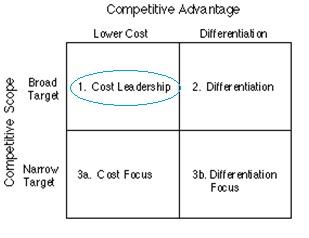- Business Concepts ›
- Marketing and Strategy ›
- Low Cost Strategy
Low Cost Strategy
Definition, Factors & Example
This article covers meaning & overview of Low Cost Strategy from marketing perspective.
What is meant by Low Cost Strategy?
Low cost strategy is a type of pricing strategy in which the firm offers the products at low price. This strategy helps to stimulate the demand & gain higher market share. The firm can gain cost advantages by increasing their efficiency, taking advantage of economies of scale, or by getting the raw material at low cost.
Factors which help Low Cost Strategy
For a firm to be cost leader and adopt low cost strategy, the following factors are important:
1. Access to capital to make significant investments.
2. Efficiency in Production system
3. Expertise to improve the manufacturing process
4. Acquire Raw materials at lower cost
5. Low labor costs
6. ability to outsource
The low cost strategy also comes up with the risk that other firms may also reduce their prices & a price war may start.

Low Cost Strategy Example
Low cost strategy is used by lot of domestic airlines which offer tickets at a very low price to acquire customers and first time fliers. This was made possible by adding frequent sectors in the routes and offering no-frills flying experience and more seating in one flight. This helped many airlines to cut cost and overall cut the ticket prices leading to more people flying in various sectors.
Hence, this concludes the definition of Low Cost Strategy along with its overview.
This article has been researched & authored by the Business Concepts Team which comprises of MBA students, management professionals, and industry experts. It has been reviewed & published by the MBA Skool Team. The content on MBA Skool has been created for educational & academic purpose only.
Browse the definition and meaning of more similar terms. The Management Dictionary covers over 1800 business concepts from 5 categories.
Continue Reading:
What is MBA Skool?About Us
MBA Skool is a Knowledge Resource for Management Students, Aspirants & Professionals.
Business Courses
Quizzes & Skills
Quizzes test your expertise in business and Skill tests evaluate your management traits
Related Content
All Business Sections
Write for Us